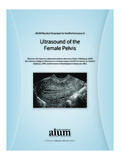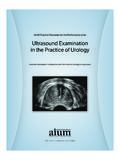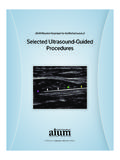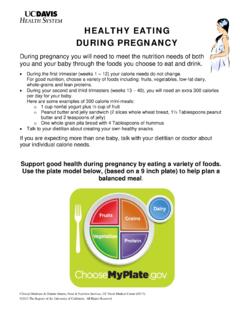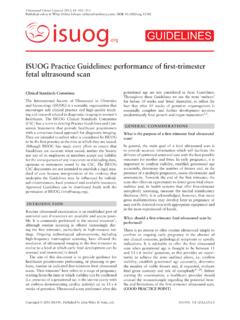Transcription of AIUM Practice Parameter for the Performance of Detailed ...
1 Practice PARAMETERAIUM Practice Parameter for thePerformance of Detailed Second- andThird-Trimester Diagnostic ObstetricUltrasound ExaminationsIntroductionThe clinical aspects of this Practice Parameter were developedcollaborativelyamong the American Institute ofUltrasound inMedicine (AIUM) and other organizations whose membersuse ultrasound for performing Detailed second- and third -trimesterdiagnostic obstetric ultrasound examinations (see Acknowledg-ments ). Recommendations for personnel requirements, the writtenrequestfortheexamination,document ation,qualitycontrol,andsafetymay vary among the organizations and may be addressed by Detailed obstetric ultrasound examination (Current Proce-dural Terminology[CPT] code 76811) is not intended to be the rou-tine ultrasound examination performed for all pregnancies.
2 Rather, itis an indication-driven examination performed for a known orsuspected fetal anatomic abnormality, known fetal growth disorder,genetic abnormality, or increased risk for a fetal anatomic or geneticabnormality or placenta accreta spectrum (PAS). Performance andinterpretation of a Detailed fetal anatomic scan require advanced skillsand knowledge and the ability to effectively communicate thefind-ings to the patient and her referring physician. Thus, the performanceof the Detailed obstetric examination should be rare outside referralpractices with special expertise in the identification and diagnosis offetal anomalies and placental implantation disorders. Only 1 suchmedically indicated study per pregnancy per Practice is appropriate.
3 If1 or more required structures are not adequately demonstrated dur-ing the 76811 examination , the patient may be brought back for afocused assessment (CPTcode 76816). A second Detailed obstetricexamination should not be performed unless there are for a Detailed fetal anatomic examination include, butare not limited to, the following conditions: 2019 by the American Institute of ultrasound in Medicine|J ultrasound Med 2019; 38:3093 3100|0278-4297| Previous fetus or child with a congenital, genetic,or chromosomal abnormality1,2;2. Known or suspected fetal anomaly or known orsuspected fetal growth restriction in the currentpregnancy2,3;3. Fetus at increased risk for a congenital anomaly,such as the following:a. Maternal pregestational diabetes or gestationaldiabetes diagnosed before 24 weeks gestation4 8;b.
4 Pregnancy conceived via assisted reproductivetechnology9;c. Maternal body mass index of 30 kg/m2orhigher10 13;d. Multiple gestations10,14;e. Abnormal maternal serum analytes15;f. Teratogen exposure16;g. First-trimester nuchal translucency measure-ment of mm or greater17;4. Fetus at increased risk for a genetic or chromo-somal abnormality, such as the following:a. Parental carrier of a chromosomal or geneticabnormality1,2;b. Maternal age of 35 years or older at delivery1,2;c. Positive screening test results for aneuploidy1,2;d. Aneuploidy marker noted on an ultrasoundexamination1,10;e. First-trimester nuchal translucency measure-ment of mm or greater17 19;5. Other conditions affecting the fetus, including thefollowing:a.
5 Congenital infections3,16,20,21;b. Maternal drug use16;c. Alloimmunization22,23;d. Oligohydramnios10;e. Polyhydramnios10,24; and6. Suspected placenta PAS or risk factors for PASsuch as placenta previa in the third trimester or aplacenta overlying a prior cesarean scar ,25,26 Qualifications and Responsibilities ofPersonnelSee for AIUM Official Statements, includ-ing Standards and Guidelines for the Accreditation ofUltrasound Practices and relevant Training Guidelines. Ifthe physician does not personally perform the examination ,he or she must provide general supervision, as defined bythe Centers for Medicare and Medicaid Services Code ofFederal Regulations : General supervision meansthe procedure is furnished under the physician s overalldirection and control, but the physician spresenceisnotrequired during the Performance of the procedure.
6 Undergeneral supervision, the training of nonphysician personnelwho actually perform the diagnostic procedure and themaintenance of the necessary equipment and supplies arethe continuing responsibility of the physician. If a sonogra-pher performs the ultrasound examination , that individualshould be credentialed in accordance with the AIUM accreditation Request for the ExaminationThe written or electronic request for an ultrasoundexamination should provide sufficient information toallow for the appropriate Performance and interpreta-tion of the request for the examination must originate froma physician or other appropriately licensed health careprovider or under the provider s direction. The accompa-nying clinical information should be provided by a physi-cian or appropriate health care provider familiar with thepatient s clinical situation and should be consistent withrelevant legal and local health care facility of the ExaminationA Detailed comprehensive obstetric ultrasound examina-tion (76811) includes all of the components of a stan-dard fetal ultrasound examination (CPTcode 76805).
7 The additional specific examination content beyondthat included in the standard examination is determinedby both the indication for the examination and the ultra-soundfindings identified during the examination and isguided by the specialized knowledge and training of theresponsible physician. The specific elements of a givendetailed obstetric ultrasound examination may be indi-vidualized based on these considerations. Therefore, aprescriptive approach to providing universally requireddetailed examination content is neither taken nor con-gruent with the nature of this indication-driven examina-tion. The table provides a list of elements that may beincluded in a Detailed examination . Based on the previ-ously noted considerations, not all of these elementsAIUM Practice Parameter for the Performance of Detailed Second- and third -Trimester Diagnostic Obstetric ultrasound Examinations3094J ultrasound Med 2019.
8 38:3093 3100 TableComponents ofCPTCode 76811 (Standard and Detailed Examinations)ComponentStandardDetailed*H ead and neckLateral cerebral ventriclesChoroid plexusMidline falxCavum septi pellucidiCerebellumCisterna magna3rd ventricle274th ventricle27 Lateral ventricular wall integrity, contour,ependymal lining27 Cerebellar lobes, vermis, and cisternamagna28 Corpus callosum29 Integrity and shape of cranial vault30 Brain parenchyma31 Neck32,33 FaceUpper lipProfile34 36 Nasal bone (15 22 wk)37 40 Coronal face (nose/lips/lens)34 Palate, maxilla, mandible, and tongue41,42 Ear position and sizeOrbitsChestHeartCardiac activity4-chamber viewLeft ventricular outflow tractRight ventricular outflow tract3-vessel view (if technically feasible)443-vessel and trachea view (if technicallyfeasible)44 SitusAortic archSuperior and inferior venae cavae43 Ductal archInterventricular septum3-vessel view443-vessel and trachea view44 ThoraxLungs45,46 Integrity of diaphragm47 Ribs48,49 AbdomenStomach (presence, size, and situs)
9 KidneysUrinary bladderCord insertion site into fetal abdomenUmbilical cord vessel numberSmall and large bowel50 52 Adrenal glands53 Gallbladder54,55 Liver56 Renal arteries57 SpleenIntegrity of abdominal wall58 SpineCervicalThoracicLumbarSacral spineIntegrity of spine and overlying softtissue59,60 Shape, curvature, conus medullaris61,62 ExtremitiesLegsArmsHandsFeetNumber, architecture, and position61 65 Digits of hands and feet: number andposition65 68 GenitaliaIn multiple gestationsWhen medically indicatedExternal genitalia69 PlacentaLocationRelationship to internal osAppearancePlacental cord insertionMasses70,71 Accessory/succenturiate lobe with locationof connecting vascular supply to primaryplacenta and internal cervical os72,73 Implantation site with evaluation forabnormal adherence25 Standard evaluationFetal numberPresentationQualitative or semiquantitative estimate ofamnioticfluid(Continues)AIUM Practice Parameter for the Performance of Detailed Second- and third -Trimester Diagnostic Obstetric ultrasound ExaminationsJ ultrasound Med 2019; 38:3093 31003095may be indicated in all Detailed obstetric ultrasoundexaminations.
10 Likewise, obtaining additional elementsnot listed in the table may be documentation is essential for high-qualitypatient care. ultrasound images that contain diagnosticinformation and/or direct patient treatment (both nor-mal and abnormal) should be recorded in accordancewith the AIUM Practice Parameter for Documentationof an ultrasound SpecificationsThese studies should be conducted with real-timescanners, using a transabdominal and/or transvaginalapproach. Real-time ultrasound is necessary to confirmthe presence of fetal life through observation of cardiacactivity and active fetal movement. The choice of trans-ducer frequency is a trade-off between beam penetrationand resolution. A transducer of an appropriate frequencyshould be used.
